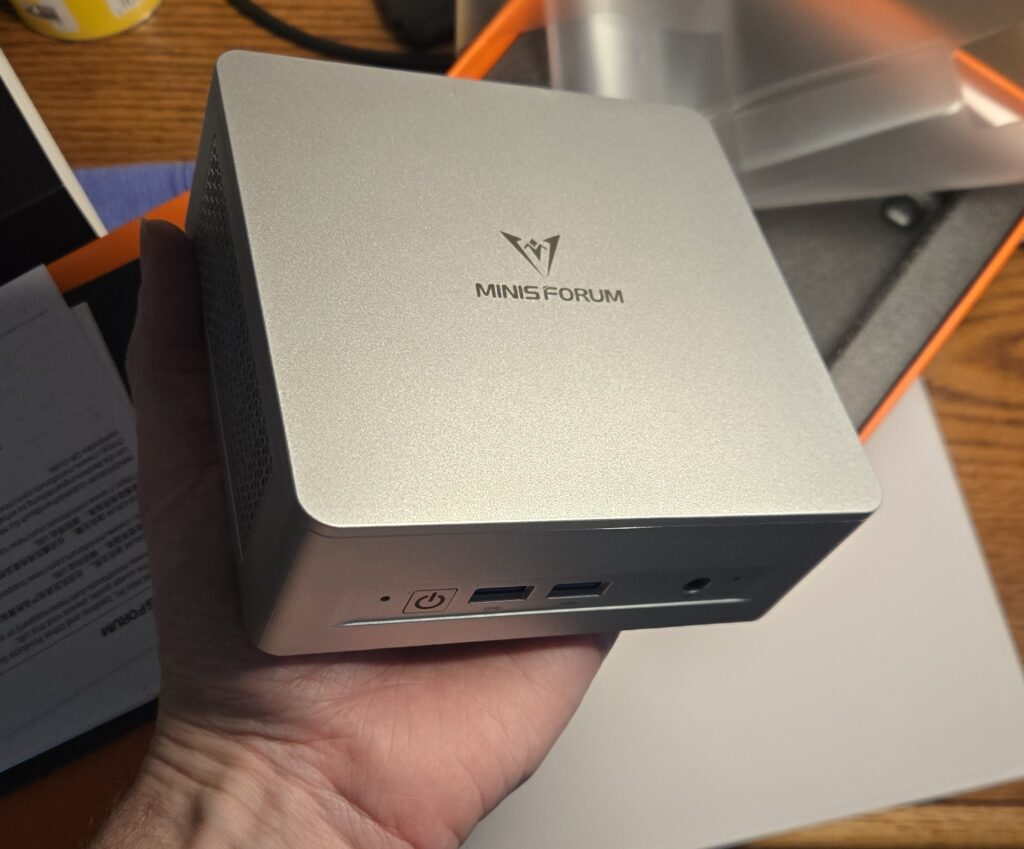I picked up a little MinisForum UM870 Slim in a 32GB/1TB configuration for about $463 on sale (from nominal $580 sticker price) a few weeks ago, just to have a decent piece of fixed hardware on my desk at home. I’d recommend these things to a large swath of the desktop market, with a few model-specific caveats. Details below.

I use some similar MinisForum UM690 and/or UM690 Pro machines on campus – folks I work with bought a couple to experiment with ROCm-on-APU, which is … theoretically compelling, but every time anyone tries it, too jank to be useful – so I was reasonably confident it would be a decent machine. A Ryzen 7 8745H is a respectable CPU and GPU, especially if you give it several GB of dedicated VRAM. It’s not a modern gaming machine or workstation, but if you’re paying under $500 it’s a really good computer-per-dollar proposition – think of all the machines in that ~1 liter size class as the guts of a upper-mid range gaming laptop, boxed up with a dramatically better cooling system since it isn’t as geometrically constrained, with prices enabled by the economies-of-scale in the relevant markets.
The Annoyances

The only major annoyance is that I wasn’t paying attention to the WiFi chipset when I picked the model. You generally haven’t had to for like a decade, because almost everything is supported everywhere… but this model ships with a Mediatek 7902, which is the only common WiFi part not supported by Linux. Mediatek has been steadfastly not releasing the documentation to write drivers for it for some time, either through malice or because they did something sketchy and covered it up in the driver – my pet theory is they’re afraid of regulatory scrutiny if users can make it do whatever FCC-forbidden thing its easily capable of. Fortunately, the WiFi module turns out to be a standard NGFF “E” key module, so I spent $20 on an Intel AX210 in a suitable m.2 A+E form-factor to replace, and it just worked, but it does make the machine $20 more expensive if you want to use Linux + WiFi. The other recent MinisForum machines I’ve encountered have MT7921 WiFi which, while not what I’d pick if I were building, works fine.
As a minor annoyance, you have to pop the adhesive feet off to access the screws to open the case… which quickly degrades the adhesive. So far mine have re-stuck, they provide a couple spares in the box, and it’d be easy to clean them and re-stick with some double-sided tape or the like, but I don’t love things designed to degrade each time they are worked on.

Even more minor annoyance: The led behind the power button is blue and BRIGHT. I cut a little piece of that 50% cut filter tape for it to chill it out – it’s not beautiful, but it’s also not an obnoxious beacon in the corner. It’s certainly not the first device I’ve done that to.
Since I was waiting on a replacement WiFi card, I let it configure the preinstalled Windows 11 system and … boy is Windows 11 infuriating. The setup process is just a barrage of ads, upsells, sneaky attempts to exfiltrate your data, and large update downloads, and it doesn’t really improve once installed. From the Fitt’s-law-violation default start bar layout, to the spray of ads for-software-not-installed that type-ahead produces, it’s not really a platform for users, and only lasted until my new WiFi card arrived and I loaded my usual Arch + KDE environment on it.
I have it hooked up to the KVM on my desk as well as the 43″ 1080p TV in my office, and I did some couch gaming playing Fallout 4 (10 years later I’m just getting to it – it’s… not as to my taste as the earlier installments). Some of it with a bluetooth-flashed Stadia controller I had lying around, for the full couch-gaming experience, which …probably didn’t help with the experience. The machine stayed quiet and had no noticeable slowdowns at 1080p on “Ultra,” which I’ll take as a fine-for-casual-gaming acceptance test. Performance was pretty consistent on Windows 11 and Linux+ Proton once reinstalled.
I’ve also played some Beyond All Reason on it, which is in my eternal rotation in the Total Annihilation and TA-Like Spring games before it. There were a few stutters (which I think were software bugs, not related to the machine), but it stayed quiet in a scaled battle, and that reliably makes my ca. 2019 big laptop make angry fan noises, so I’ll call the cooling system solid.
They’re also not just toys, a small low-idle-power-consumption machine with a decent chunk of memory and many threads is also great as a little server. I have one of the UM690s on campus rigged up with Proxmox to run VMs for obstinate software (Xilinx FPGASoC toolchains with everything properly co-versioned, ancient Windows VM for talking to shit that wants to be manged by ActiveX or Java applets over TLS1.0, etc.) and it’s been really good at that kind of job too.
I’m not sure what I’d do with much more computer these days, which makes these little things a great value proposition.

